CFD Investigation of the Hydraulic Short-Circuit Mode in the FMHL/FMHL+ Pumped Storage Power Plant
Abstract
1. Introduction
2. Description of the FMHL/FMHL+ Power Plant
3. Numerical Setup
- At the inlet of the computational domain, i.e., at the pump side, the flow rate is imposed according to the operating point of the powerplant listed in the Table 2. The velocity profile is assumed uniform and the turbulent intensity is set to a default value of 5%.
- At the outlet section in the direction to the turbine, a mass flow rate is imposed to fix the percentage of the pumped flow deviated to the turbine, i.e., the percentage of HSC.
- At the outlet section in the direction of the upper reservoir, the static pressure is set except when the entire part of the pumped flow is deviated to the turbine (100% HSC mode). In this latter case, a free slip wall condition is imposed, and the pressure is specified at the outlet of the pipe in direction of the turbine.

4. Results and Analysis
4.1. Intragroup Hsc Mode
- kg/m the density
- the area-weighted average of the total pressure at the inlet section.
- the area-weighted average of the average total pressure at the outlet section in the direction to the turbine
- is the bulk flow velocity in the pumping pipe, as sketched in Figure 4.

4.2. Intergroup Hsc Mode
4.3. Interplant Hsc Mode
5. Comparison of the Bifurcations
6. Conclusions
Author Contributions
Funding
Data Availability Statement
Acknowledgments
Conflicts of Interest
Abbreviations
| BSL-EARSM | Baseline Explicit Algebraic Reynolds Stress Mode |
| CC | Curvature Correction |
| CFD | Computational Fluid Dynamics |
| FMHL | Force Motrice Hongrin-Léman |
| HSC | Hydraulic short-circuit |
| PSP | Pumped-Storage hydro-power Plants |
| RANS | Reynolds-Averaged Navier-Stokes |
| SST | Shear Stress Transport |
References
- Guittet, M.; Capezzali, M.; Gaudard, L.; Romerio, F.; Vuille, F.; Avellan, F. Study of the drivers and asset management of pumped-storage power plants historical and geographical perspective. Energy 2016, 111, 560–579. [Google Scholar] [CrossRef]
- Rocks, A.; Meusburger, P. The Electrical Asset and Mechanical Machinery of Obervermuntwerk II. Wasserwirtsch 2015, 105, 48–52. [Google Scholar] [CrossRef]
- Micoulet, G.; Jaccard, A.; Rouge, N. FMHL+: Power extension of the existing Hongrin-Léman powerplant: From the first idea to the first kWh. In Proceedings of the Hydro Conference, Montreux, Switzerland, 10–12 October 2016. [Google Scholar]
- Pérez-Díaz, J.I.; Sarasúa, J.I.; Wilhelmi, J.R. Contribution of a hydraulic short-circuit pumped-storage power plant to the load–frequency regulation of an isolated power system. Int. J. Electr. Power Energy Syst. 2014, 62, 199–211. [Google Scholar] [CrossRef]
- Decaix, J.; Biner, D.; Drommi, J.-L.; Avellan, F.; Münch-Alligné, C. CFD simulations of a Y-junction for the implementation of hydraulic short-circuit operating mode. IOP Conf. Ser. Earth Environ. Sci. 2021, 774, 012013. [Google Scholar] [CrossRef]
- Huber, B.; Korger, H.; Fuchs, K. Hydraulic Optimization of a T-junction–Hydraulic Model Tests and CFD Simulation. In Proceedings of the XXXI IAHR Congress, Seoul, Republic of Korea, 11–16 September 2005. [Google Scholar]
- Decaix, J.; Drommi, J.-L.; Avellan, F.; Münch-Alligné, C. CFD simulations of hydraulic short-circuits in junctions, application to the Grand’Maison power plant. IOP Conf. Ser. Earth Environ. Sci. 2022, 1079, 012106. [Google Scholar]
- HydroLEAP–Modernizing the Swiss Hydropower Fleet for a Successful Energy Strategy 2050; Annual Report. Available online: https://www.aramis.admin.ch/Dokument.aspx?DocumentID=69905 (accessed on 17 May 2022).
- Schlipf, M.; Tismer, A.; Riedelbauch, A. On the application of hybrid meshes in hydraulic machinery CFD simulations. IOP Conf. Ser. Earth Environ. Sci. 2016, 49, 2013. [Google Scholar] [CrossRef]
- Kwak, D.; Kiris, C.C. Computation of Viscous Incompressible Flows; Springer GmbH: Berlin/Heidelberg, Germany, 2010. [Google Scholar]
- Menter, F.R. Review of the shear-stress transport turbulence model experience from an industrial perspective. IOP Int. J. Comput. Fluid Dyn. 2009, 23, 305–316. [Google Scholar] [CrossRef]
- Wallin, S.; Johansson, A.V. An explicit algebraic Reynolds stress model for incompressible and compressible turbulent flows. J. Fluid Mech. 2000, 403, 89–132. [Google Scholar] [CrossRef]
- Smirnov, P.E.; Menter, F.R. Sensitization of the SST Turbulence Model to Rotation and Curvature by Applying the Spalart–Shur Correction Term. J. Turbomach. 2002, 131, 89–132. [Google Scholar] [CrossRef]
- Wallin, S.; Johansson, A.V. Modelling streamline curvature effects in explicit algebraic Reynolds stress turbulence models. Int. J. Heat Fluid Flow 2002, 23, 721–730. [Google Scholar] [CrossRef]
- Menter, F.R.; Ferreira, J.; Esch, T.; Konno, B. The SST Turbulence Model with Improved Wall Treatment for Heat Transfer Predictions in Gas Turbines. In Proceedings of the International Gas Turbine Congress, Tokyo, Japan, 2–7 November 2003. [Google Scholar]
- Durbin, P.; Pettersson-Reif, B.A. Statistical Theory and Modeling for Turbulent Flows; Wiley: Hoboken, NJ, USA, 2011; Volume 376. [Google Scholar]
- Bailly, C.; Comte-Bellot, G. Turbulence; Springer GmbH: Berlin/Heidelberg, Germany, 2015. [Google Scholar]
- Degani, D.; Seginer, A.; Levy, Y. Graphical visualization of vortical flows by means of helicity. AIAA J. 1990, 28, 1347–1352. [Google Scholar]
- Kalpakli Vester, A.; Örlü, R.; Alfredsson, P.H. Turbulent Flows in Curved Pipes: Recent Advances in Experiments and Simulations. Appl. Mech. Rev. 2016, 68, 721–730. [Google Scholar] [CrossRef]


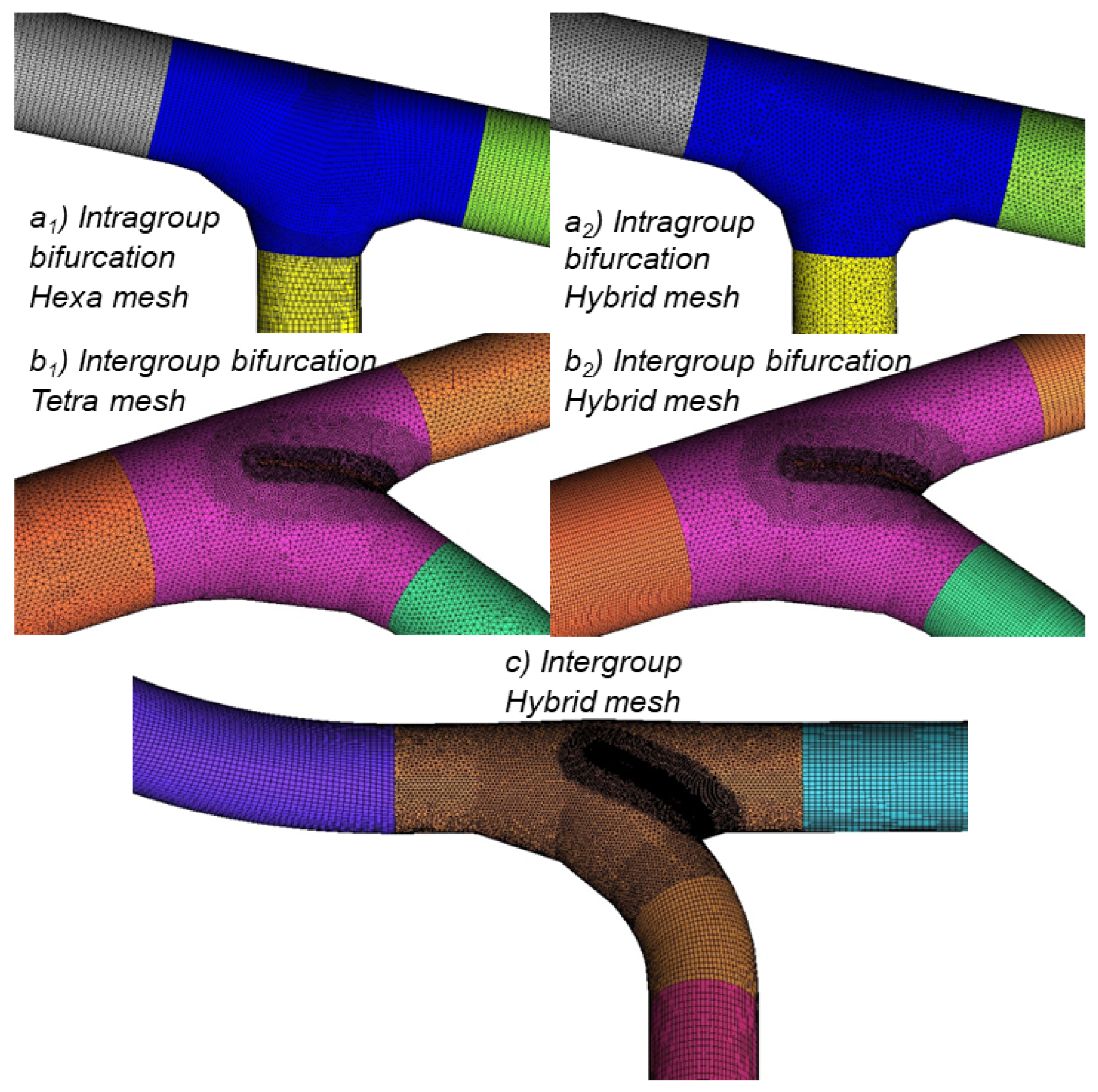
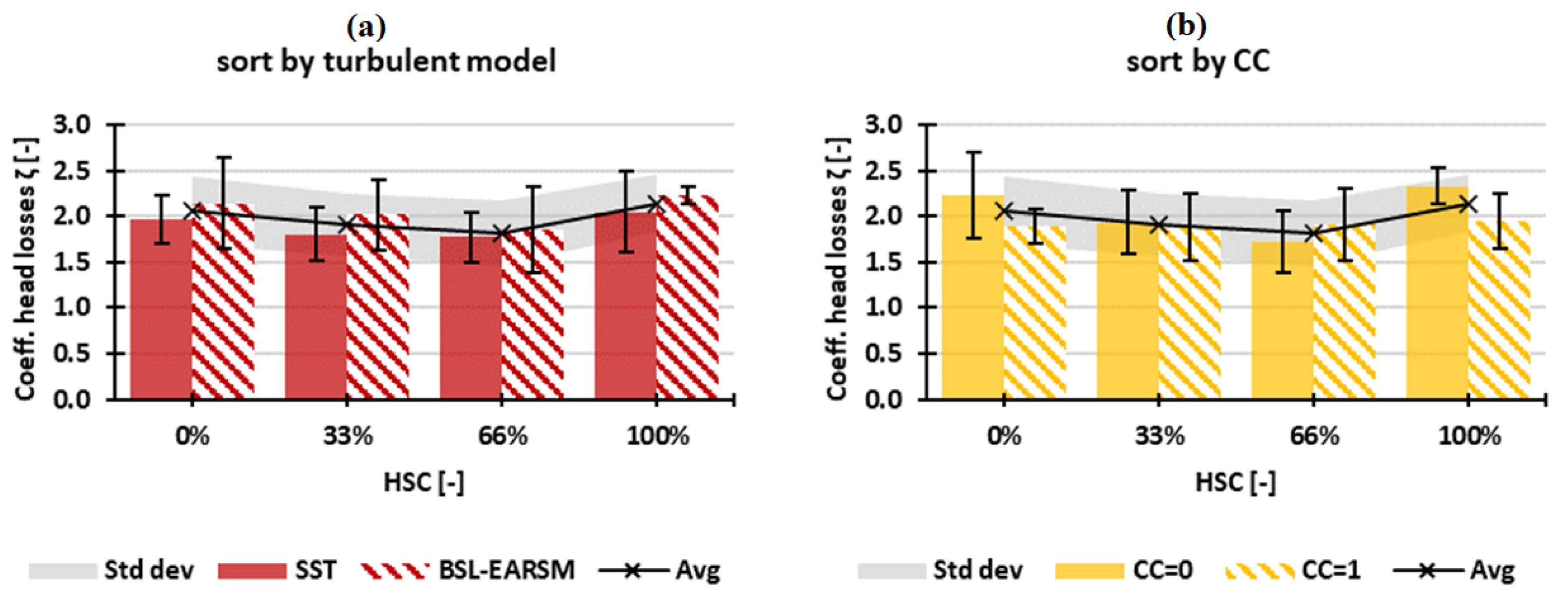

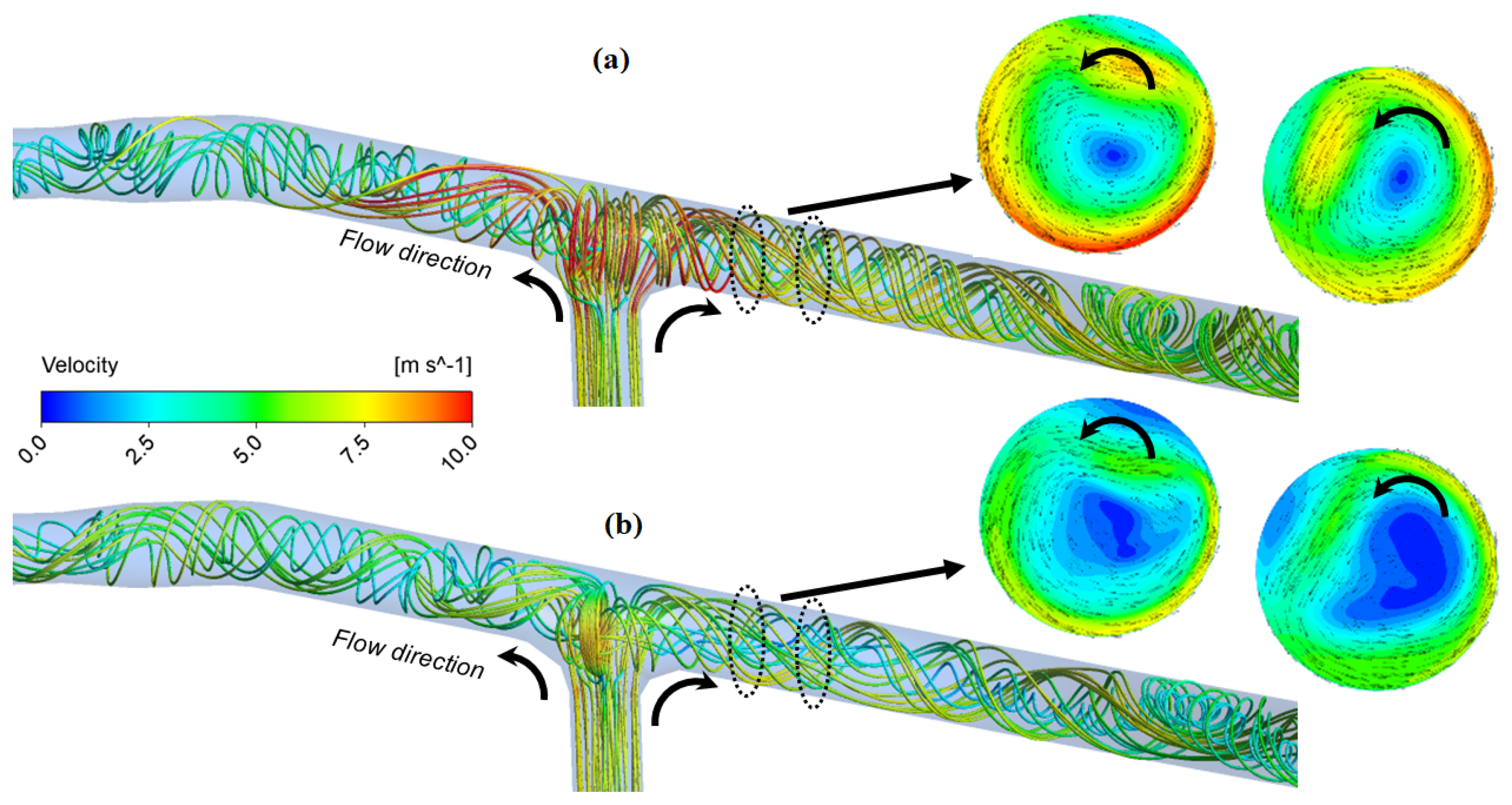
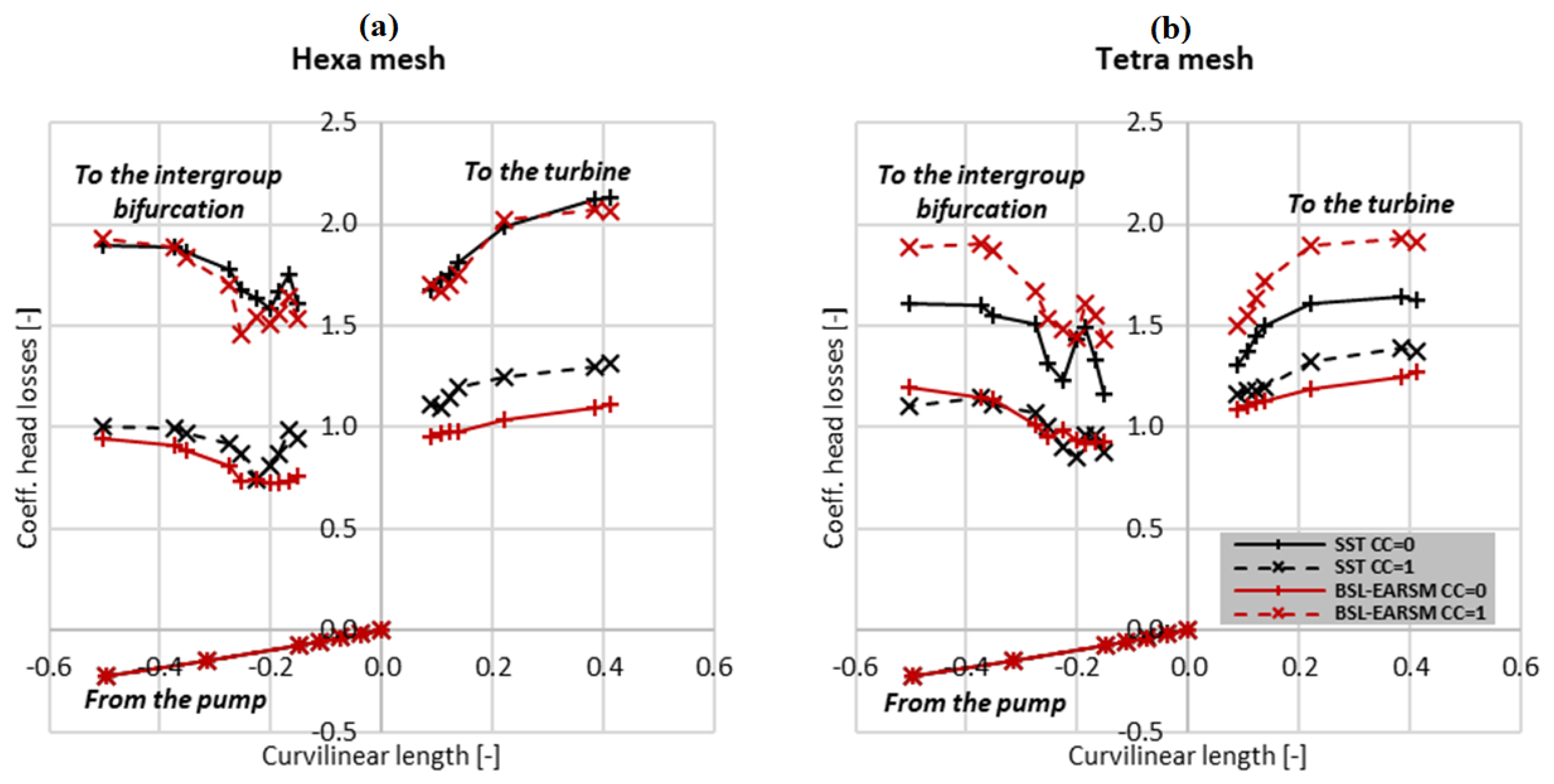
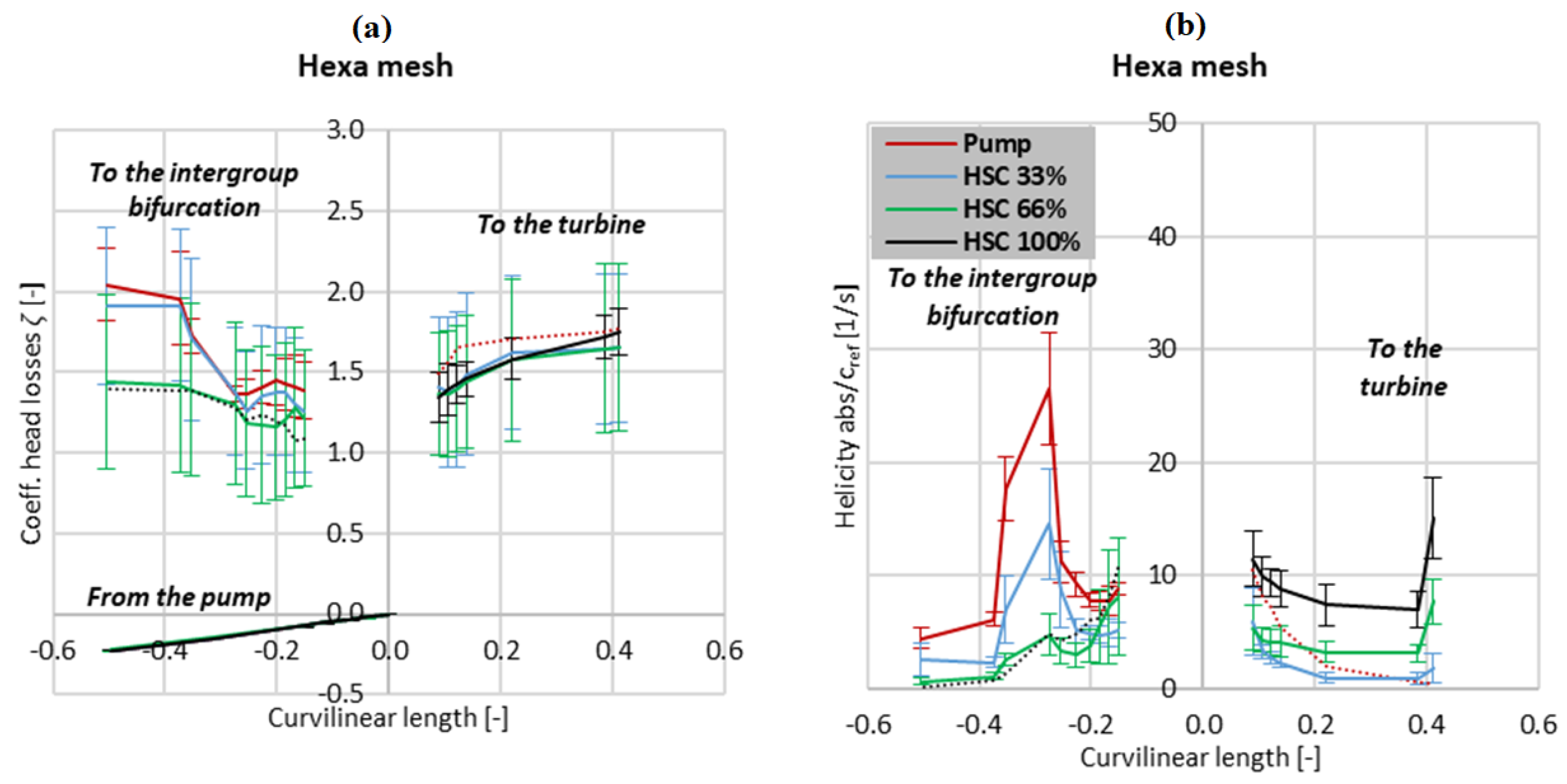

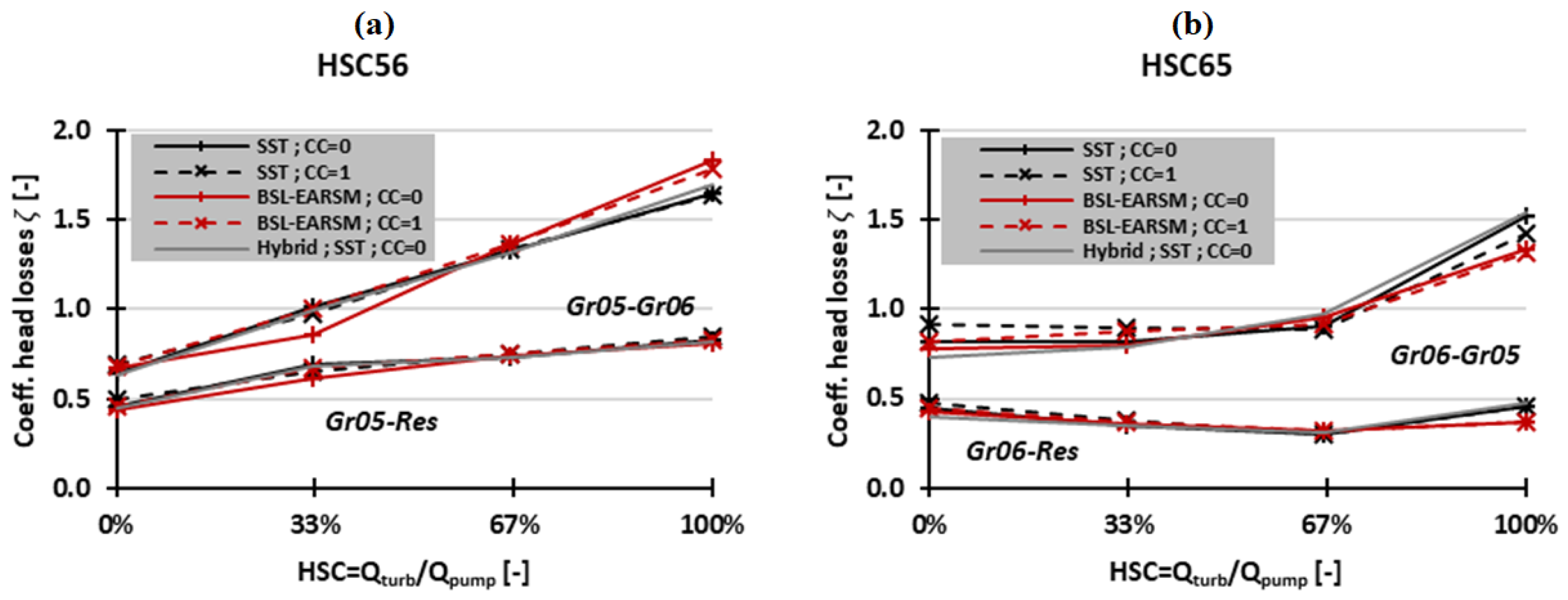
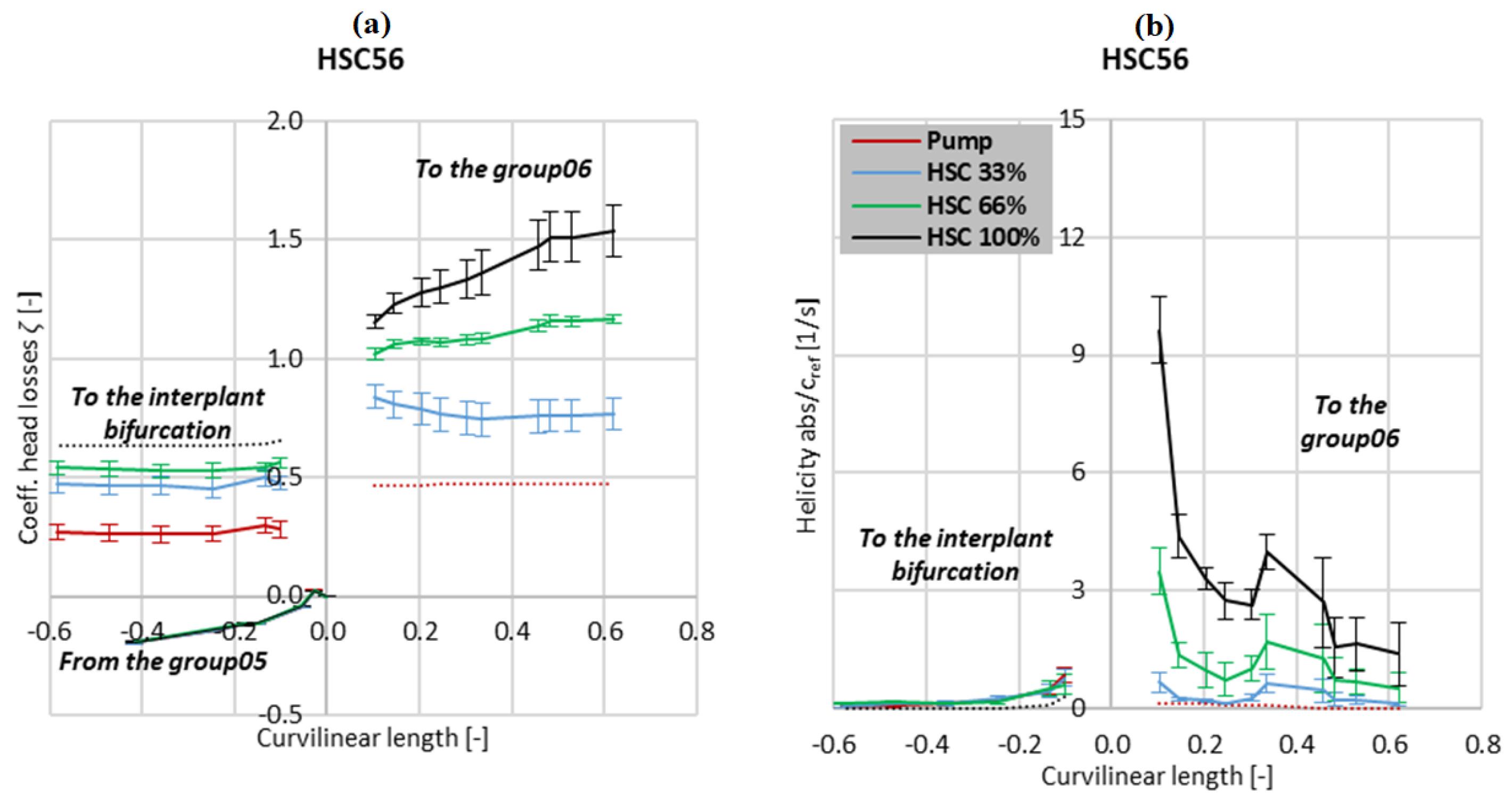
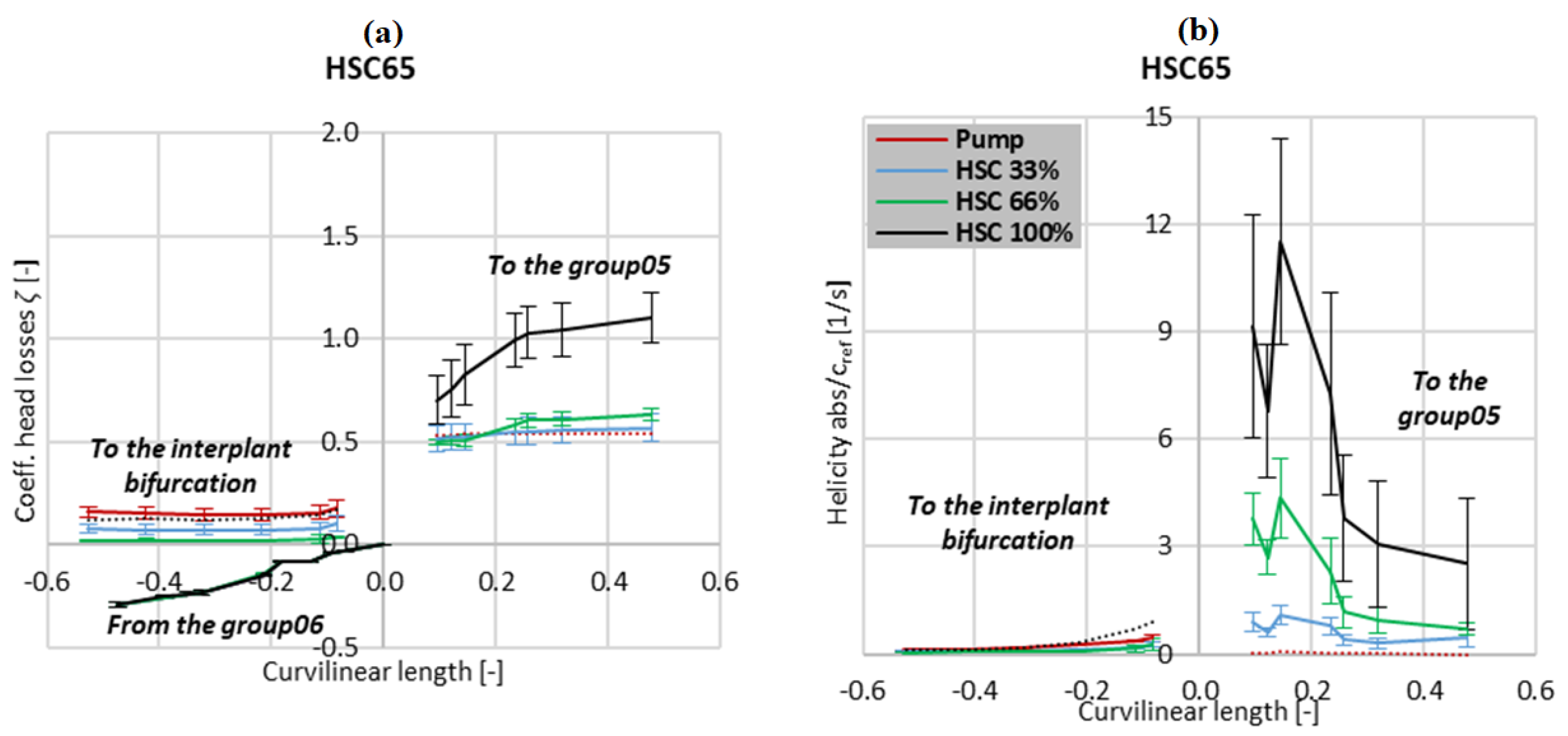
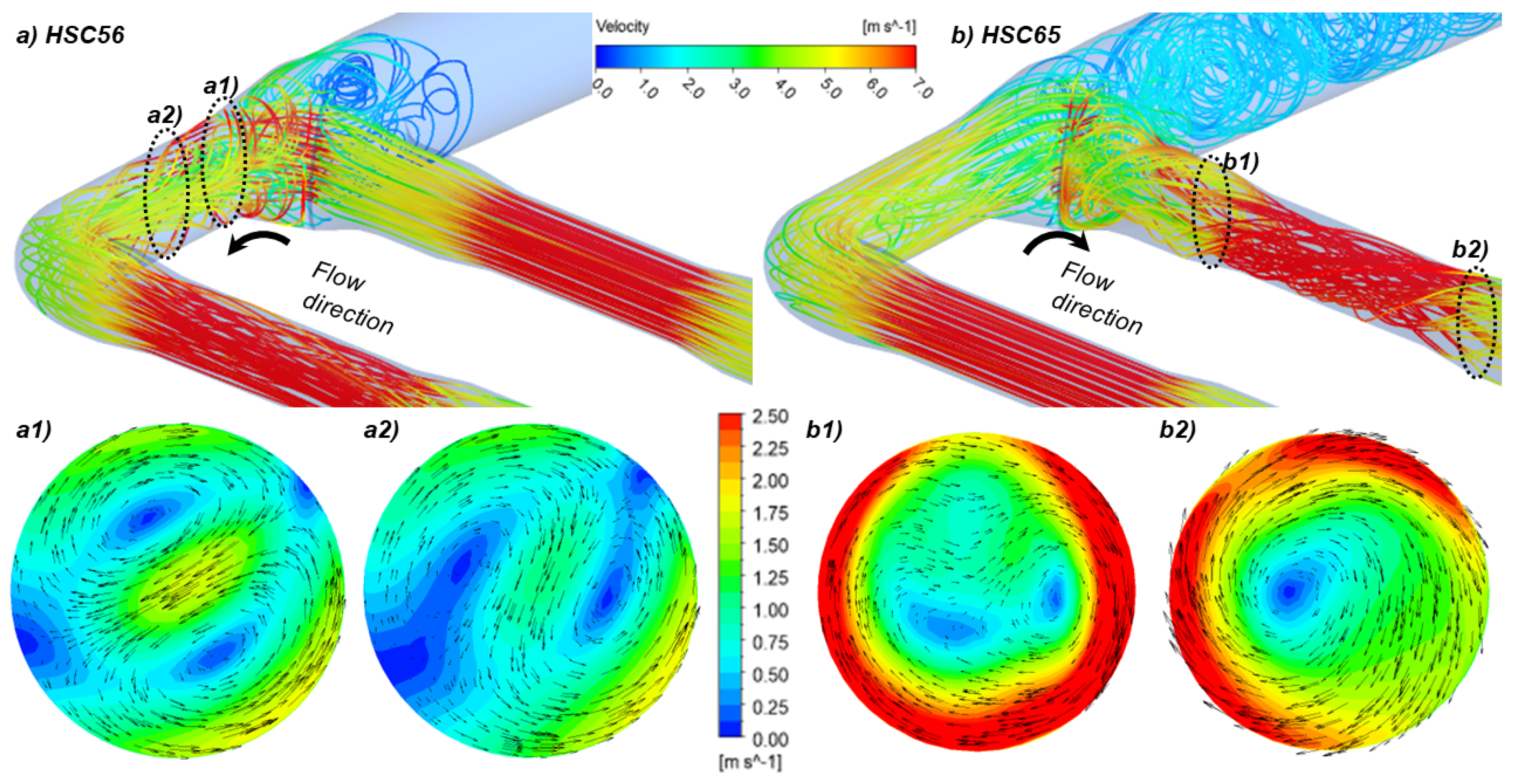
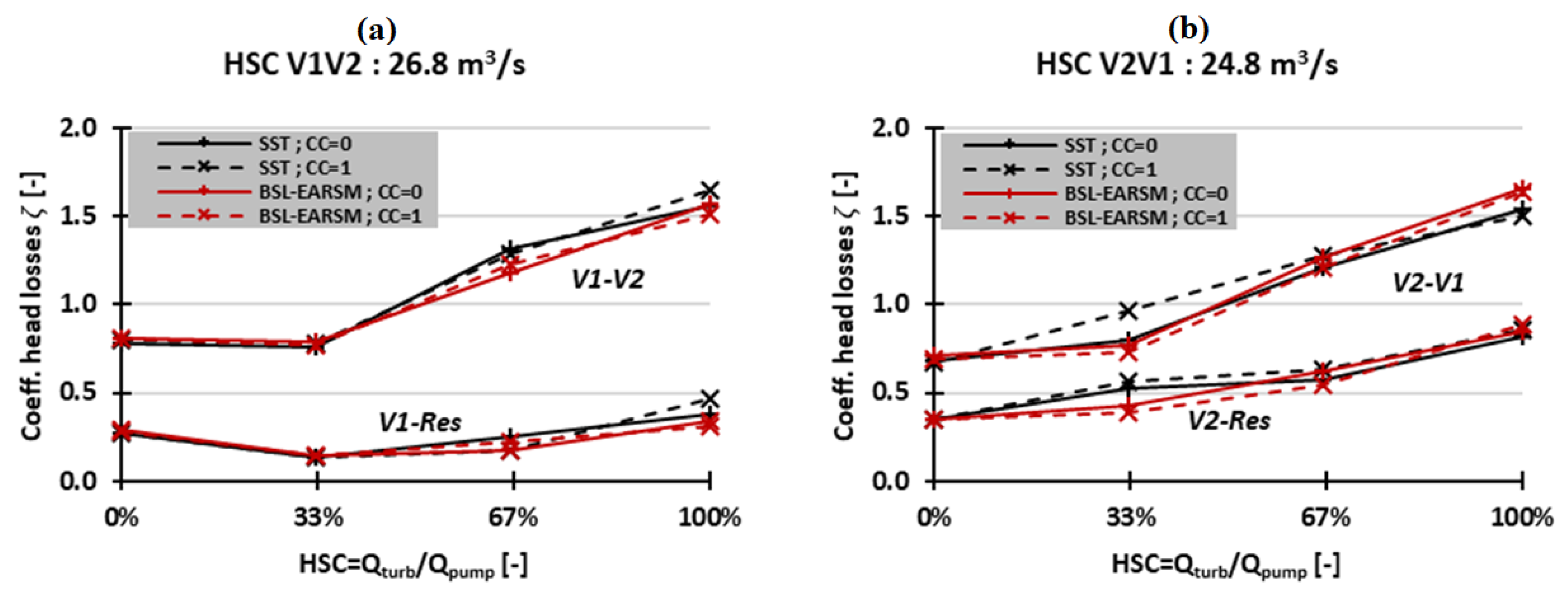

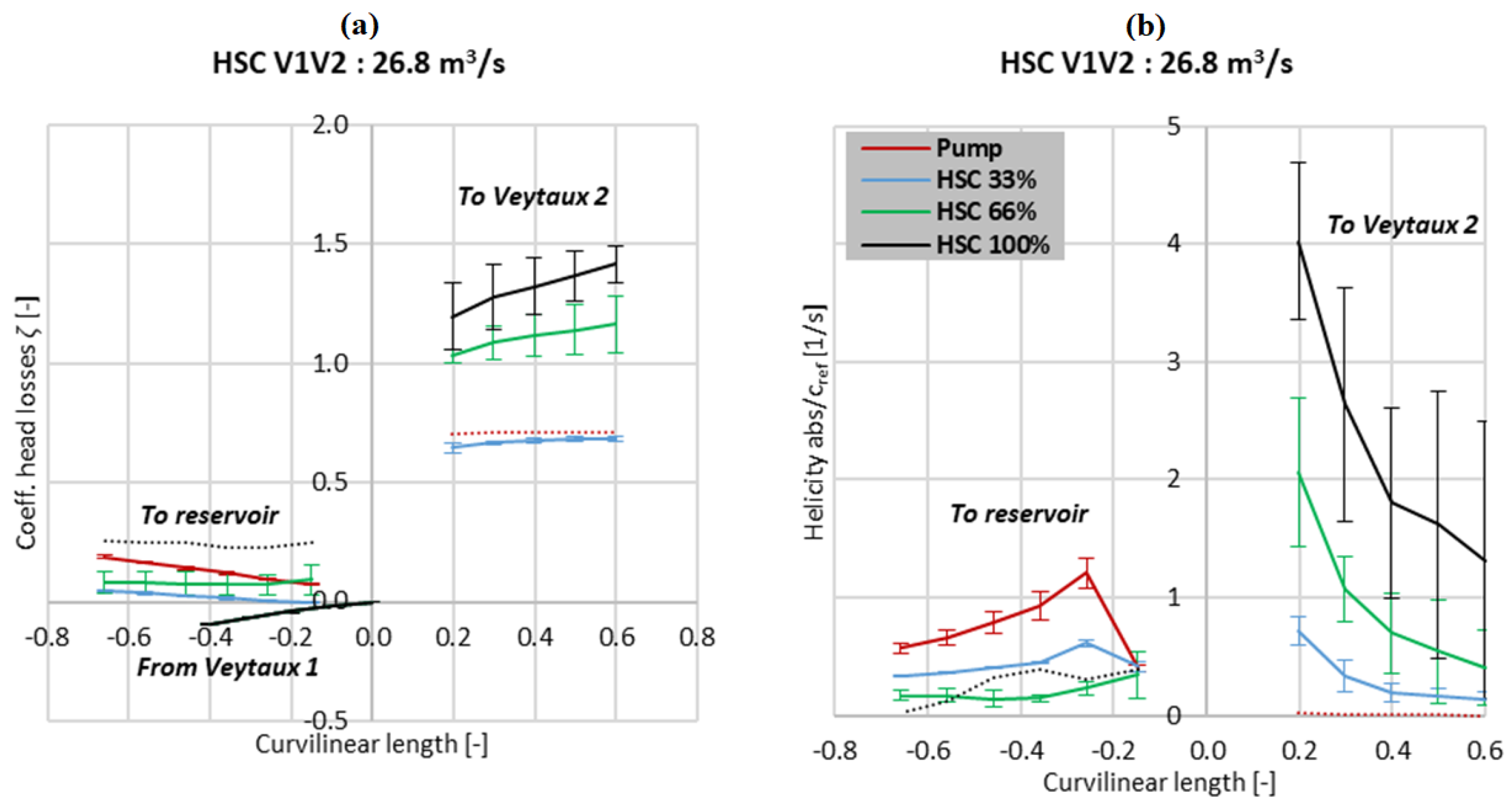
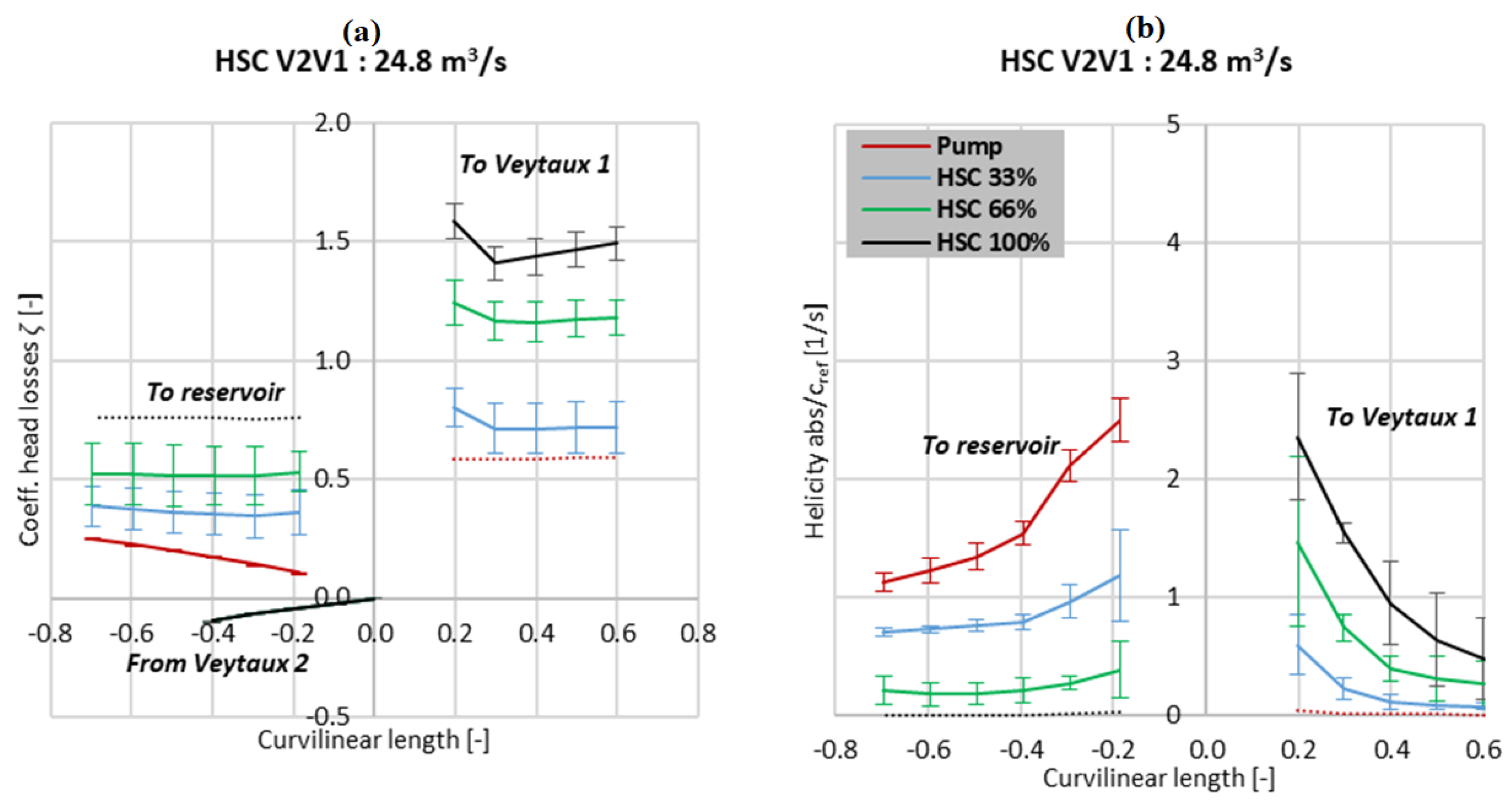
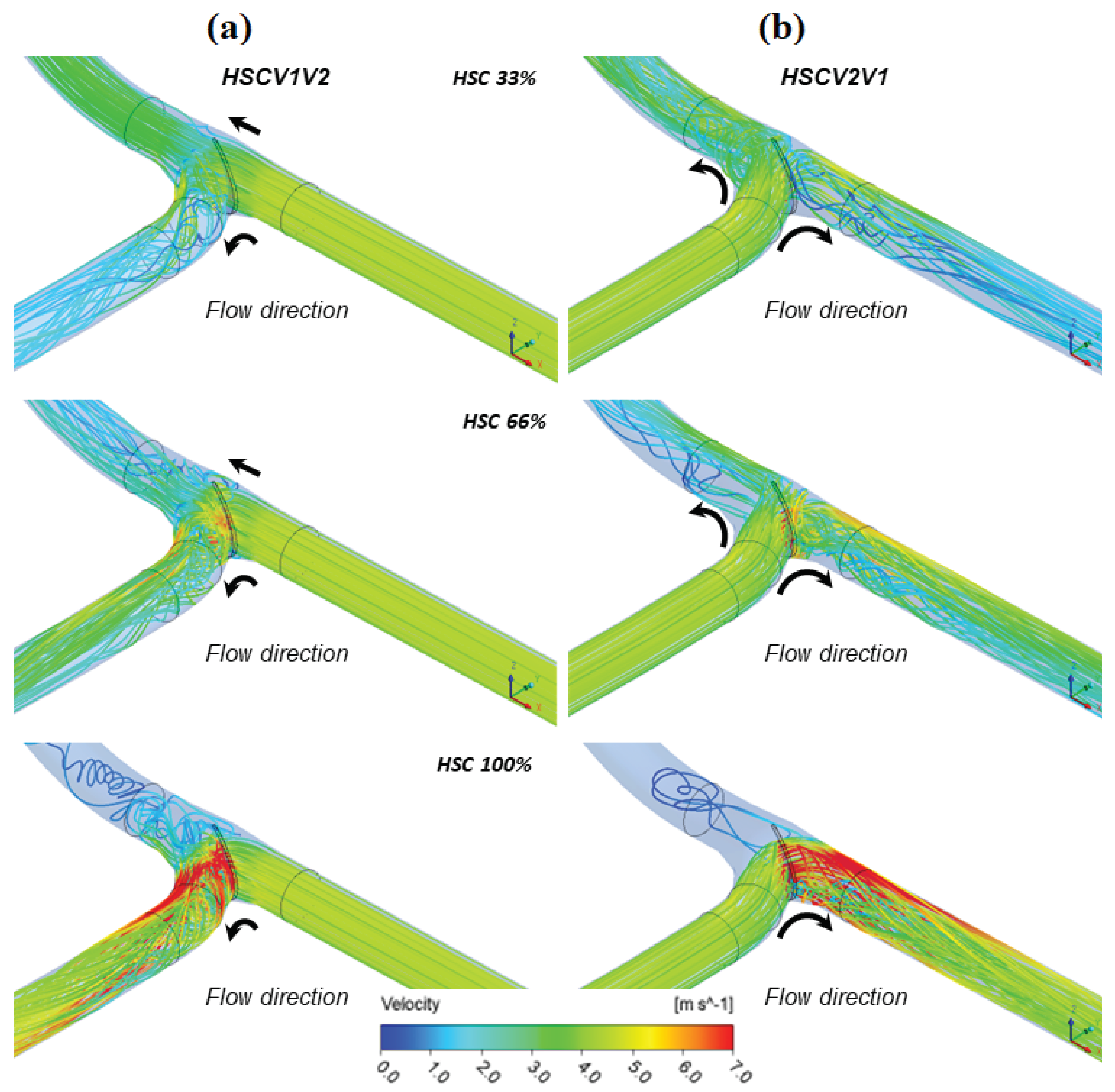
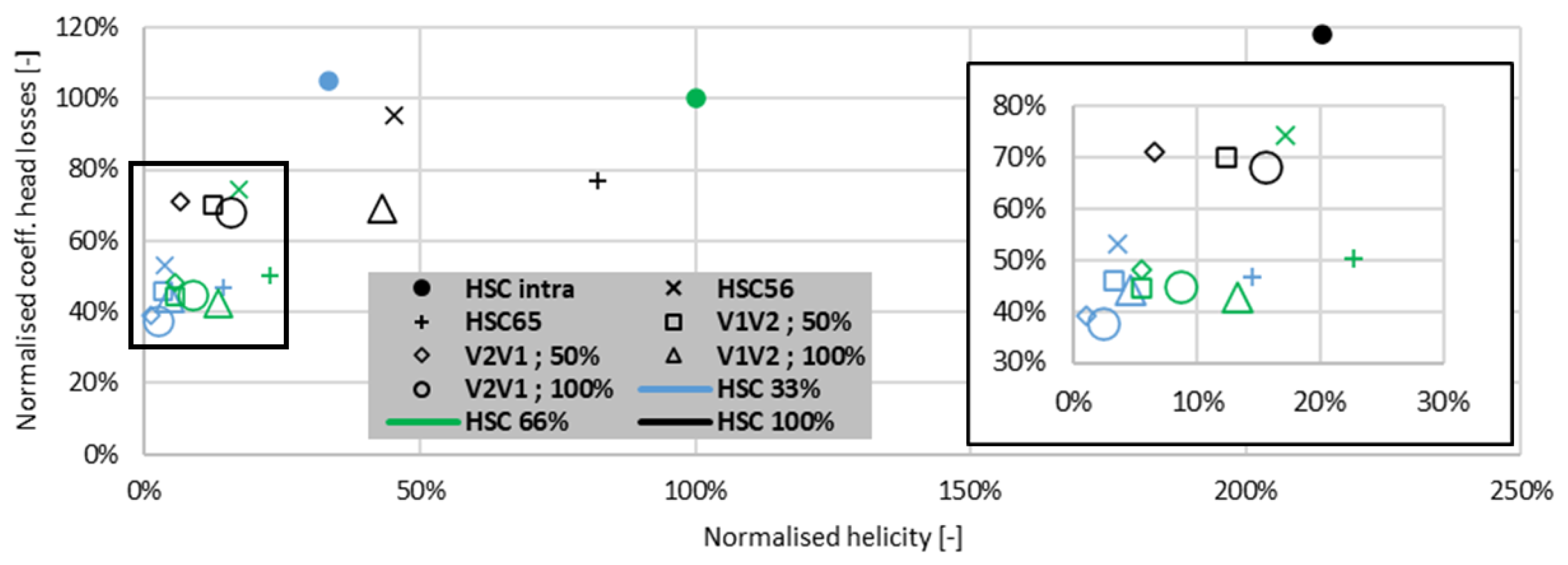
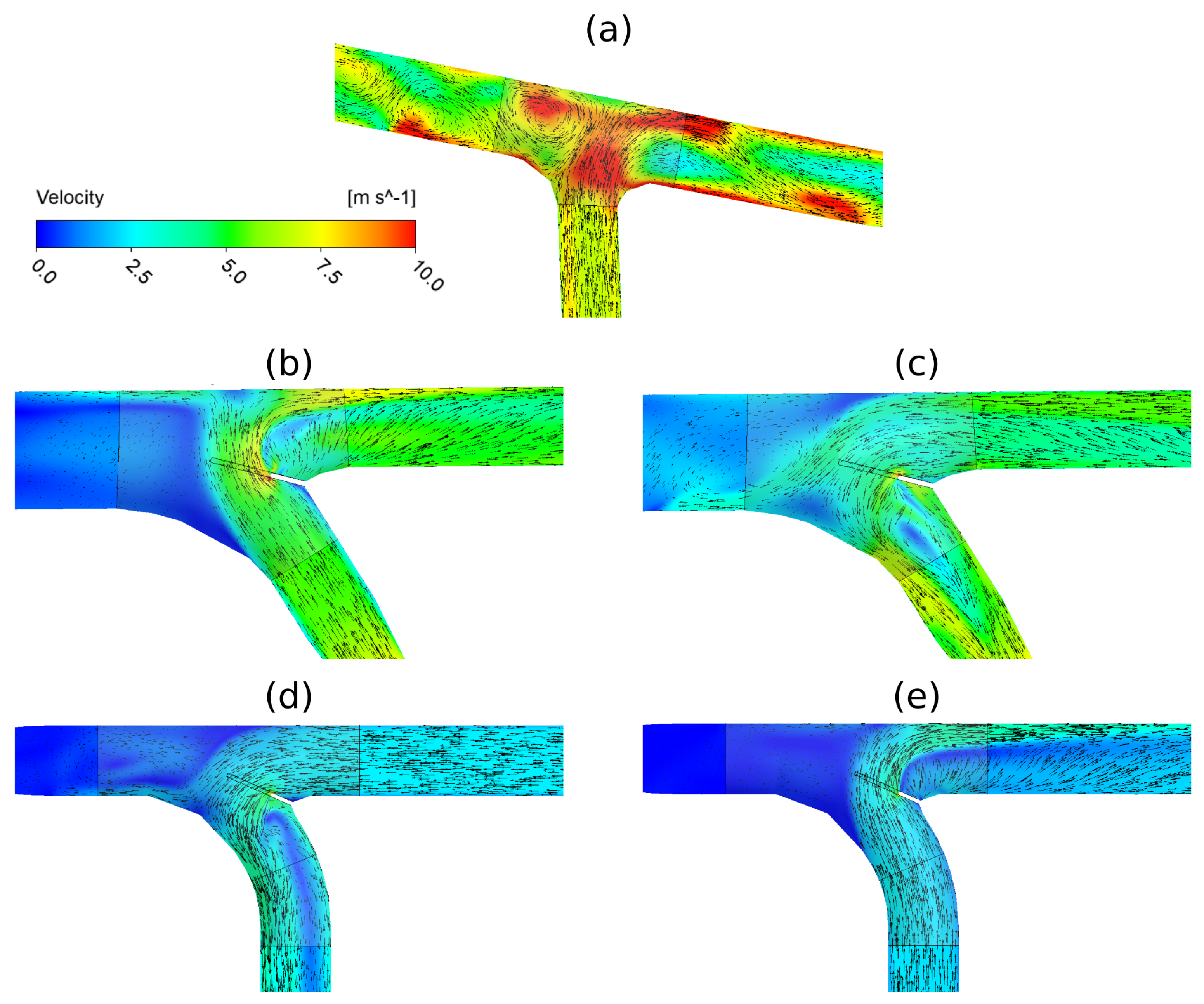
| Intragroup Bifurcation | Intergroup Bifurcation | Interplant Bifurcation | |||
|---|---|---|---|---|---|
| Mesh type | Hexa | Tetra + prisms | Tetra + prisms | Hybrid Hexa/Tetra + prisms | Hybrid Hexa/Tetra + prisms |
| Max element size [mm] | 100 | 100 | 150 | 150 | 150 |
| Number of elements [millions] | 6.36 | 8.19 | 5.64 | 2.01/2.11 | 1.45/3.11 |
| Number of prisms layers [-] | - | 30 | 20 | -/15 | -/12 |
| Height of the first cell [mm] | 0.01 | 0.01 | 1 | 1 | 1 |
| Maximum y+ [-] | 9 | 6 | 687 | 1034 | 719 |
| Averaged y+ [-] | 3 | 3 | 183 | 308 | 189 |
| Averaged quality | 0.96 | 0.92 | 0.89 | 0.93/0.87 | 0.96/0.87 |
| Pumping Plant | Pumping Group | Intragroup | Intergroup | Interplant | ||||||
|---|---|---|---|---|---|---|---|---|---|---|
| Veytaux II | Group 5 | 12.4 | 12.4 | 12.4 | 12.4 | |||||
| Group 6 | 12.4 | 12.4 | 12.4 | |||||||
| Veytaux I | Group 1 | 6.7 | 6.7 | 6.7 | 6.7 | |||||
| Group 2 | 6.7 | 6.7 | 6.7 | |||||||
| Group 3 | 6.7 | 6.7 | ||||||||
| Group 4 | 6.7 | |||||||||
| Pumping flow rate [m/s] | 12.4 | 12.4 | 12.4 | 12.4 | 24.8 | 6.7 | 13.4 | 20.1 | 26.8 | |
| Reynolds number [-] | 110 | 3.2 | 130 | |||||||
| Intragroup | Intergroup 56 | Intergroup 65 | Interplant Single Flowrate V1V2 | Interplant Single Flowrate V2V1 | Interplant Double Flowrate V1V2 | Interplant Double Flowrate V2V1 | |
|---|---|---|---|---|---|---|---|
| HSC 33% | 105% | 53% | 47% | 46% | 39% | 44% | 38% |
| HSC 66% | 100% | 74% | 50% | 45% | 48% | 43% | 45% |
| HSC 100% | 118% | 95% | 77% | 70% | 71% | 69% | 68% |
| Intragroup | Intergroup 56 | Intergroup 65 | Interplant Single Flowrate V1V2 | Interplant Single Flowrate V2V1 | Interplant Double Flowrate V1V2 | Interplant Double Flowrate V2V1 | |
|---|---|---|---|---|---|---|---|
| HSC 33% | 33% | 4% | 14% | 3% | 1% | 5% | 2% |
| HSC 66% | 100% | 17% | 23% | 6% | 5% | 13% | 9% |
| HSC 100% | 214% | 45% | 82% | 12% | 7% | 43% | 16% |
Disclaimer/Publisher’s Note: The statements, opinions and data contained in all publications are solely those of the individual author(s) and contributor(s) and not of MDPI and/or the editor(s). MDPI and/or the editor(s) disclaim responsibility for any injury to people or property resulting from any ideas, methods, instructions or products referred to in the content. |
© 2024 by the authors. Licensee MDPI, Basel, Switzerland. This article is an open access article distributed under the terms and conditions of the Creative Commons Attribution (CC BY) license (https://creativecommons.org/licenses/by/4.0/).
Share and Cite
Decaix, J.; Mettille, M.; Hugo, N.; Valluy, B.; Münch-Alligné, C. CFD Investigation of the Hydraulic Short-Circuit Mode in the FMHL/FMHL+ Pumped Storage Power Plant. Energies 2024, 17, 473. https://doi.org/10.3390/en17020473
Decaix J, Mettille M, Hugo N, Valluy B, Münch-Alligné C. CFD Investigation of the Hydraulic Short-Circuit Mode in the FMHL/FMHL+ Pumped Storage Power Plant. Energies. 2024; 17(2):473. https://doi.org/10.3390/en17020473
Chicago/Turabian StyleDecaix, Jean, Mathieu Mettille, Nicolas Hugo, Bernard Valluy, and Cécile Münch-Alligné. 2024. "CFD Investigation of the Hydraulic Short-Circuit Mode in the FMHL/FMHL+ Pumped Storage Power Plant" Energies 17, no. 2: 473. https://doi.org/10.3390/en17020473
APA StyleDecaix, J., Mettille, M., Hugo, N., Valluy, B., & Münch-Alligné, C. (2024). CFD Investigation of the Hydraulic Short-Circuit Mode in the FMHL/FMHL+ Pumped Storage Power Plant. Energies, 17(2), 473. https://doi.org/10.3390/en17020473







